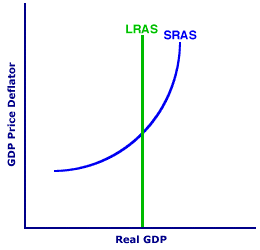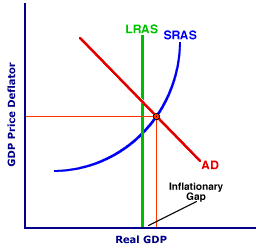Contractionary fiscal policy is designed to restrain the economy during or anticipation of an inflation-inducing business-cycle expansion. This is accomplished by decreasing aggregate expenditures and aggregate demand through a decrease in government spending (both government purchases and transfer payments) or an increase in taxes. Contractionary fiscal policy leads to a smaller government budget deficit or a larger budget surplus.In general, contractionary fiscal policy works through the two sides of the government's fiscal budget -- spending and taxes. However, it's often useful to separate these two sides into three specific tools -- government purchases, taxes, and transfer payments.
Government Purchases
One of the three fiscal policy tools available to the government sector is government purchases. Government purchases are expenditures by the government sector, especially those by the federal government, on final goods or services. It is that portion of gross domestic product purchased by governments.These purchases are used to buy everything from aircraft carriers to paper clips, from office furniture to highway construction, from traffic lights to teacher salaries. The actual purchases are typically undertaken by individual government agencies. Highway construction, for example, is undertaken with funds appropriated to the Department of Transportation. Aircraft carriers are financed with funds appropriated to the Department of Defense.
Contractionary fiscal policy involves a decrease in the funds appropriated to these assorted agencies. The agencies then reduce their purchases which decreases aggregate production, income, and the rate of inflation.
While a decrease in government purchases have been used frequently over the years to implement contractionary fiscal policy, it can be a relatively involved process. For this reason, policy makers often opt for the second fiscal policy tool -- taxes.
Taxes
The second of three fiscal policy tools is taxes, primarily personal income taxes levied by the federal government, but other taxes are also used. Taxes are the involuntary payments that the government sector imposes on the rest of the economy to generate the revenue needed to provide public goods and to undertake other government functions. Personal income taxes are more specifically the taxes collected on the income received by members of the household sector.The federal income tax system, administered by the Internal Revenue Service (IRS), involves a set of tax rates that are applied to the income received by the taxpayers. The bulk of the taxes are withheld from employee paychecks by then paid to the federal government by employers. And discrepancy between taxes withheld and the actual tax liability is then settled when income tax returns are filed at the end of the year.
Contractionary fiscal policy involves either an increase of the income tax rates or a one-time surcharge. The increase in taxes provides the household sector with less disposable income that can be used for consumption expenditures, which then reduces aggregate production and employment and leads to further decreases in income, thus reducing inflationary pressure.
While tax changes tend to be administratively easier to implement than government purchases, they are less political palatable to political leaders and voters who prefer lower taxes to higher taxes. Higher taxes have been used as part of contractionary fiscal policy, but sparingly.
Transfer Payments
The third fiscal policy tool is transfer payments. Transfer payments are payments made by the government sector to the household sector with no expectations of productive activity in return. The three common transfer payments are Social Security benefits to the elderly and disable, unemployment compensation to the unemployed, and welfare to the poor.Like the income tax system, transfer payments rely on a payment schedule based on qualifying characteristics of the recipients -- age, employment status, income, etc. Those who meet the criteria then receive payments.
Contractionary fiscal policy involves either a decrease in payment schedule for one or more of the transfer systems or perhaps some sort of across-the-board reduction in payments to all who qualify. That is, the unemployment compensation might be decreased by 5 percent or all Social Security recipients might receive a reduction of $100 in their monthly check. The decrease in transfer payments reduces the disposable income available to the household sector, which then forces a reduction in consumption expenditures, leading to less aggregate production and employment and subsequently a decrease in inflationary pressures.
Inflationary Gap
Contractionary fiscal policy is used to address business-cycle instability that gives rise to the problem of inflation, that is, to close an inflationary gap. An inflationary gap exists if the existing level of aggregate production is greater than what would be produced with the full employment of resources. This gap arises during a business-cycle expansion and typically gives rise to higher rates of inflation.| Inflationary Gap | 
|
An inflationary gap is commonly illustrated using the aggregate market (AS-AD analysis). The exhibit to the right presents the standard aggregate market. The vertical long-run aggregate supply curve, labeled LRAS, marks full-employment real production. Long-run equilibrium in the aggregate market necessarily results in full-employment real production.The positively-sloped short-run aggregate supply curve is labeled SRAS. Short-run equilibrium in the aggregate market occurs at the price level and real production corresponding to the intersection of the aggregate demand curve and this SRAS curve. Should short-run real production rise above of full-employment real production, then an inflationary gap results. However, to identify this gap an aggregate demand curve needs to be added to the graph.
To include an aggregate demand curve that generates an inflationary gap for this aggregate market, click the [Inflationary Gap] button. Doing so reveals a short-run equilibrium level of real production that is greater than full employment, which is an inflationary situation. Note that the aggregate demand curve intersects the SRAS curve at a real production level to the right of the LRAS curve. This means the short-run real production is greater than full-employment real production. The difference between short-run equilibrium real production and full-employment real production is the inflationary gap.
Closing the Gap
Contractionary fiscal policy is designed to close an inflationary gap by changing aggregate expenditures and shifting the aggregate demand curve. An inflationary gap is closed with a leftward shift of the aggregate demand curve.| Inflationary Gap | 
|
To illustrate how this occurs, consider the exhibit to the right. The top panel presents an inflationary gap. The inflationary gap can be closed with contractionary fiscal policy -- a decrease in government purchases, an increase in taxes, or a decrease in transfer payments. This policy shifts the aggregate demand curve to the left and closes the gap. To illustrate how this works, click the [Contractionary Policy] button. If done correctly, the aggregate demand curve intersects the short-run aggregate supply curve at the full employment level of aggregate production indicated by the long-run aggregate supply curve.Other Policy Options
Contractionary fiscal policy is one of several stabilization policies available to the federal government to address business-cycle problems. The Federal Reserve System can also get into the act of restraining the economy through contractionary monetary policy. Or the Congress and the President can direct actions toward unemployment problems through expansionary fiscal policy.- Contractionary Monetary Policy: To correct the excesses of business-cycle expansion and address the problem of inflation, the Fed can decrease the money supply and increase interest rates. This is accomplished by selling U.S. Treasury securities in the open market, raising the discount rate, and increasing reserve requirements.
- Expansionary Fiscal Policy: Fiscal policy can also be used to address unemployment problems created by a business-cycle contraction. Expansionary fiscal policy is the opposite of contractionary fiscal policy. It consists of increasing government purchases, decreasing taxes, and increasing transfer payments. The resulting increase in the aggregate expenditures, causes an increase in aggregate production and thus reduces unemployment.
CONTRACTIONARY FISCAL POLICY, AmosWEB Encyclonomic WEB*pedia, http://www.AmosWEB.com, AmosWEB LLC, 2000-2025. [Accessed: July 18, 2025].


